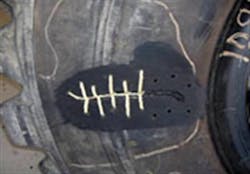This is the first in a special two-part series on OTR tire repair. In the April edition of CTD, we will take a look at how H & H Industries Inc. and Walters Tire Service Inc. approach OTR tire repair.
The shortage of new OTR tires combined with a mild winter in much of the United States has been a blessing for companies specializing in OTR tire repair.
Demand has outstripped supply for new tires, so end users are banking on repairs to keep their machines moving.
Stockton, Calif.-based BigFoot Tire Repair LLC has seen a hefty increase in business over the past year, with no slowdown in sight.
BigFoot Tire performs spot or section repairs on more than 50 extensively damaged earthmover tires per month.
The company is a newcomer to the U.S. market (since May 2006) but was in operation for 20 years in the Philippines.
[PAGEBREAK]
Its principals include Rob Haywood, a company partner; Jack Lewis, who oversees sales and marketing; and Sid Benedicto, BigFoot Tire's general manager.
Benedicto also holds the patent on BigFoot Tire's OTR repair process. That's what sets BigFoot Tire apart from other firms that offer OTR tire repair, according to company officials. His process uses Kevlar cord stitching to reinforce repairs and enhance the structural integrity of the repaired tire.
"From there we secure the injury area with a proprietary stitching process using Kevlar cord," says Lewis. "Kevlar cord ensures there's no bucking or bubbling in the repair process, and it restores the structural integrity that's lost because of the injury.
"This process allows us to not only do crown repairs but also sidewall repairs with a high level of confidence."
BigFoot Tire is currently working with a couple of independent laboratories to "establish empirical evidence of the quality of our repairs to restore the structural integrity of the tire based on our repair process." Results are due in this fall.
"We adhere to all current manufacturers' and Tire Industry Association repair guidelines for preparing the injury area," Lewis explains, "but that's where the comparisons (to other OTR tire repair systems) stop."
Super opportunity
Most of the BigFoot Tire's customers are in California, but the company is branching out into Arizona and Nevada.
Clients include independent tire dealers who specialize in OTR tire sales such as Pro One and Lamar Tire Service, plus national commercial chains such as Wingfoot Commercial Tire Centers LLC (owned by Goodyear Tire & Rubber Co.), Tire Centers LLC (owned by Michelin North America Inc.), and Bandag Inc.'s Tire Distribution Systems.
[PAGEBREAK]
Haywood says BigFoot Tire "prides itself on customer service and focuses on getting a rapid return for our customers. Due to the fact that there's an OTR tire shortage and a strain on a lot of retreaders who do repairs, we thought there was an opportunity to enhance the turnaround time of tire repairs, specifically in spots and sectionals.
"So on a weekly basis, we solicit our customers so we can understand what tires they have in stock and what they anticipate getting in.
"We try to make sure we coordinate getting those needed tires in our shop and turning them around within a week.
"And due to our patented process, we have the opportunity to fix tires that require extreme repairs -- tires that would normally have been thrown out.
"We have a situation where you have more demand than you have supply," adds Lewis. "This gives us a great opportunity to save people from maybe laying up a machine because they couldn't get the tires for it."
Send in the reinforcements: Kevlar helps restore tire integrity
BigFoot Tire Repair LLC in Stockton, Calif., utilizes its own patented OTR tire repair process that reinforces the injury and restores the tire's integrity, the company says.
Here are the steps in the process:
1. The injury is exposed, and the repair strategy is determined.
2. The injury is reinforced with Kevlar secure-lock stitch.
3. The injury exterior is coated and cemented.
4. The injury interior is coated, cemented and patched.
5. The injury exterior is built up with natural rubber cord.
6. The injury is cured in a Vulcan unit to seal and harden the rubber.
7. The tire is shaped to match the current profile and tire specs.
8. The tire is resealed, painted and marked for proper use.




